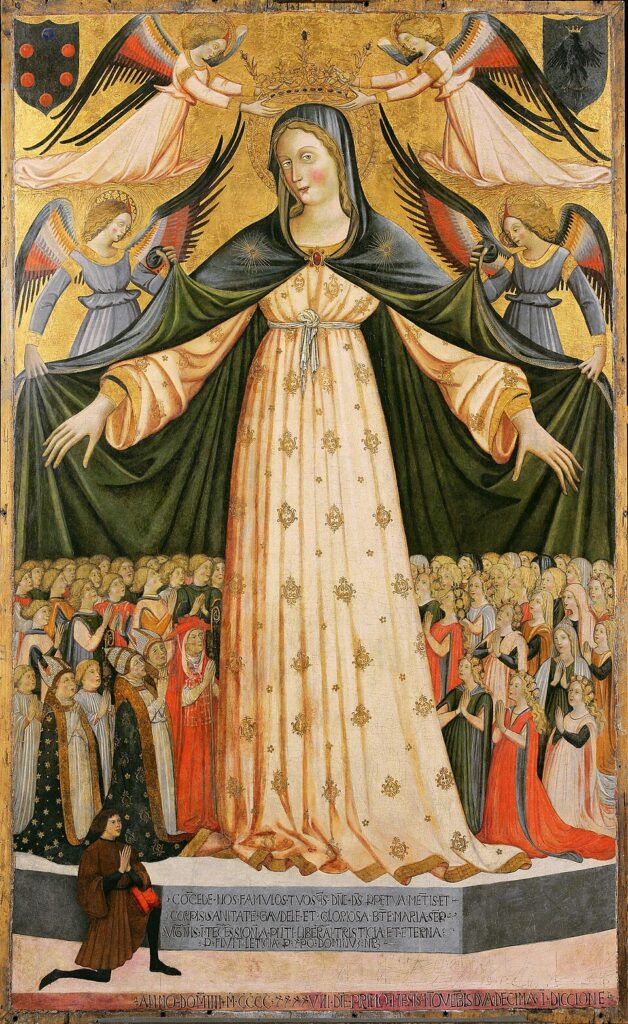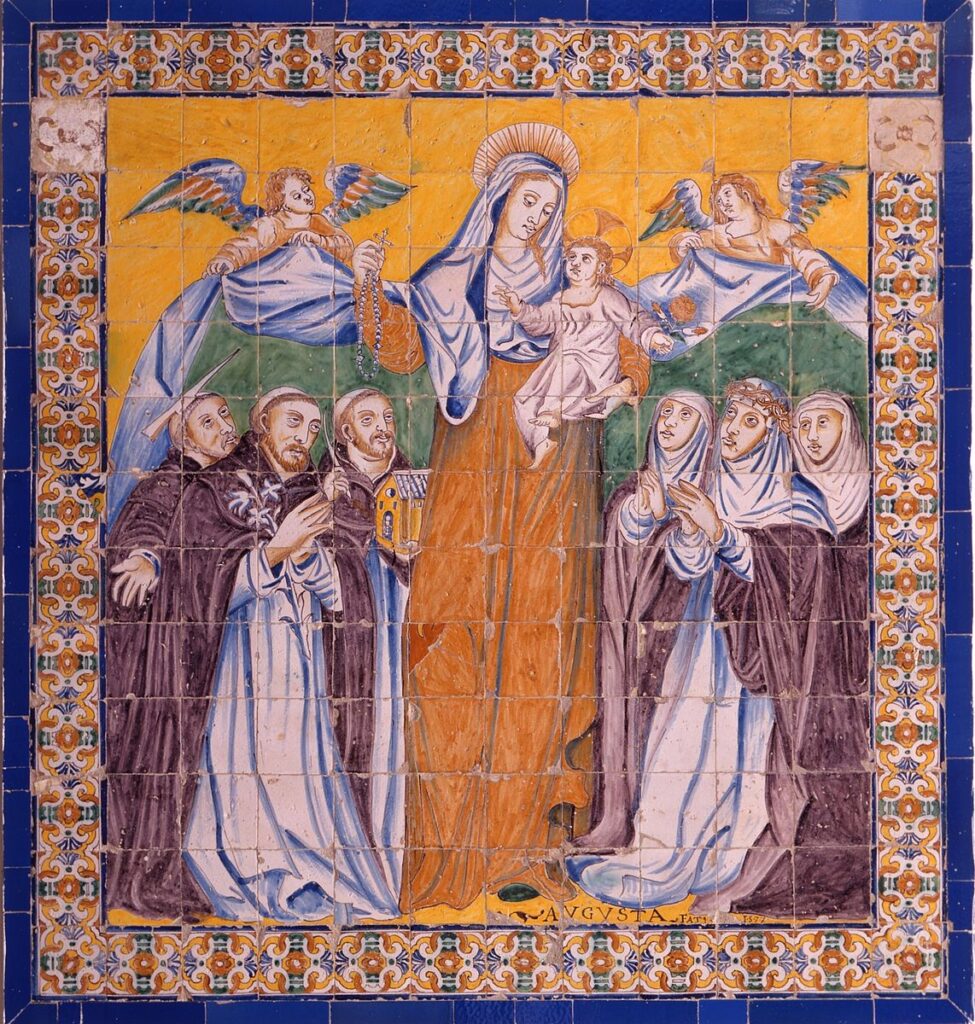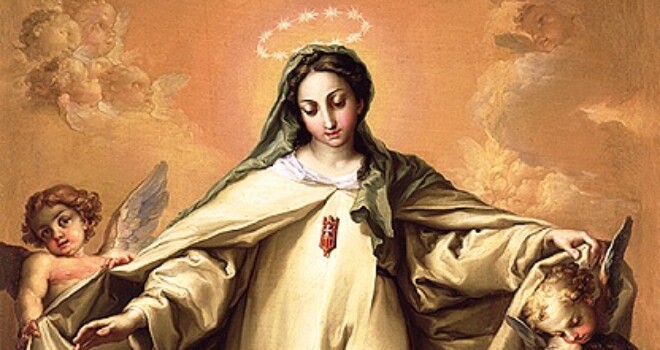In the Salve Regina (the Hail, Holy Queen, as it begins in English), Mary quickly receives the title, Mother of Mercy. Later in that prayer, we call out to her, admitting that we are “mourning and weeping in this valley of tears,” and we beg her to turn her “eyes of mercy toward us.” During May, especially in this turbulent period of history, I suggest we enhance our devotion to Mary, Mother of Mercy, so that she will intercede on our behalf to her Beloved Son.
It seems appropriate to begin with a basic definition of mercy. Merriam-Webster defines it as “a blessing that is an act of divine favor or compassion,” and “compassionate treatment of those in distress.” In the Hebrew language, this idea is conveyed by the word hesed, and it is often also translated in the Old Testament as “steadfast love” or “steadfast kindness.”
From the earliest period of Judeo-Christian revelation, hesed has been understood as God’s greatest attribute. This attribute guides the development of the Torah. The Book of Exodus, for example, acclaims, “The Lord, the Lord, a God merciful and gracious, slow to anger and abounding in steadfast love for thousands, forgiving iniquity and transgression and sin” (Ex. 34:6-7). The refrain resounds in the messages of the prophets. Jonah cries out, “I knew that you are a gracious God and merciful, slow to anger and abounding in steadfast love” (Jon. 4:3); Micah acclaims that God “does not retain his anger forever, because he delights in steadfast love” (Mic. 7:18). This idea even guides Israelite culture in the post-exilic period. When reminding Israel of their collective transgressions, Nehemiah prays, “But you are a God ready to forgive, gracious and merciful, slow to anger and abounding in steadfast love, and did not forsake them” (Neh. 9:17).
Of course, this divine attribute—this message—comes to its full fruition in Jesus Christ, the incarnation of the Father’s merciful, steadfast love. Jesus’ messianic teaching is replete with the ideas, the truths, that make up the very definition of mercy. He continually acted in ways that showed divine favor and compassion, especially toward those who were distressed. This is precisely why Our Blessed Lord quoted Isaiah to lay out the way He would go about His mission (see Lk. 4:17-21).
On the Cross, Jesus gave His own mother to the beloved disciple, who stands as a type for each of us. We can conclude, then, that Jesus and His Heavenly Father intend for Mary to serve as Mother of Mercy. She is to be intimately involved in the outpouring of mercy, as intercessor and messenger, just as every good mother is to her children.
Christians have called on Mary’s intercession and patronage in distress since at least the mid-third century (about A.D. 250). There is an ancient prayer text addressed to her, originally composed in Greek and commonly known as the Sub Tuum in Latin. The prayer specifically calls on her tenderness, or mercy, to deliver Christian disciples from danger and difficulty. The Salve Regina—which Catholics commonly pray at the end of the Rosary, at the conclusion of Night Prayer in the Divine Office, and sometimes at the end of Masses—was authored and composed sometime around the turn of the twelfth century. The Rosary as we know it today began as a common devotion shortly thereafter.
In the modern era, when mercy has become extraordinarily necessary, Mary has brought a message of mercy for the world through visionaries. In 1830, she appeared in Paris, at the Rue de Bac, to Sr. Catherine Labouré. The essence of her message in these apparitions was the necessity and benefit of reaching out for her intercession during a period of history that would see “the whole world . . . plunged into gloom.”
Nearly three decades later, in 1858, Our Lady appeared at Lourdes, in Pyrenees Mountains of France, and the most memorable part of her message dealt with mercy and compassion. Since the middle of the nineteenth century, malades (French for sick and disabled persons) from around the world make pilgrimage to the apparition site, where a miraculous spring of healing water developed. It is important to recall, though, that the miraculous healings were accompanied by a call to personal conversion.
Finally, in 1917, Mary appeared in Fatima, Portugal, and informed three young shepherds that turning toward Jesus by devotion to her Immaculate Heart would lead to triumph over all the evils that would beset the world in the twentieth century. Each of these apparitions conveys God’s merciful heart that overflows with steadfast tenderness toward those who face physical and spiritual maladies. More specifically, each of these apparitions reveals Mary as a tender and merciful mother who wants to point her children toward her Divine Son’s merciful and Sacred Heart, and as an intercessor for the world populated by persons in enormous amounts of physical and spiritual distress.


As we are pondering the reality of God’s steadfast love and tender mercy, two images from the Church’s rich artistic tradition come to mind. The first is Mater Misericordiae, by Giovanni da Gaeta, produced in the mid-fifteenth century. In this piece, the Blessed Mother looks directly toward the viewer with what seem to be her “eyes of mercy.” Two angels bestow a crown on her, recognizing her as the Queen of Heaven. Two other angels, flanking her on either side, stretch out her blue mantle over a host of persons who signify the “poor, banished children of Eve.” Mary extends her hands over the whole group.
The other image is a tilework from the late sixteenth century titled Virgen del Rosario, by Cristóbal de Augusta. Some of its details imitate the first piece: Mary is in the center, and the angels at her side spread her flowing blue mantle wide over a group of people. The tilework is different, though, because it depicts Mary holding the Child Jesus in her left arm and a Rosary in her extended right hand. The group of people beneath Mary’s mantle are six Dominican saints. Clearly, the artist depicted these saints particularly because the Order of Preachers was the first to promote devotion to the Rosary, the best-known tool in Catholic history to invoke Mary’s merciful intercession: “. . . pray for us sinners, now and at the hour of our death.”


Thus, throughout May, it will be a great boon for our spirits if we cultivate our devotion to Mary, Mother of Mercy. We ought to place ourselves among the people protected by her merciful mantle of intercession. We ought to take up the Rosary, fervently—daily, even. We ought to acclaim her as our Holy Queen, as we call her at the beginning of the prayer. That way, during our “mourning and weeping,” she can mercifully share with us her life, her sweetness, and her hope, which we surely need.
Author’s Note: See John Cavadini’s detailed and illuminating article in Church Life Journal for an incredibly insightful commentary on the composition of the Salve Regina, the Sub Tuum, and another great piece of art.
Image from Wikipedia














